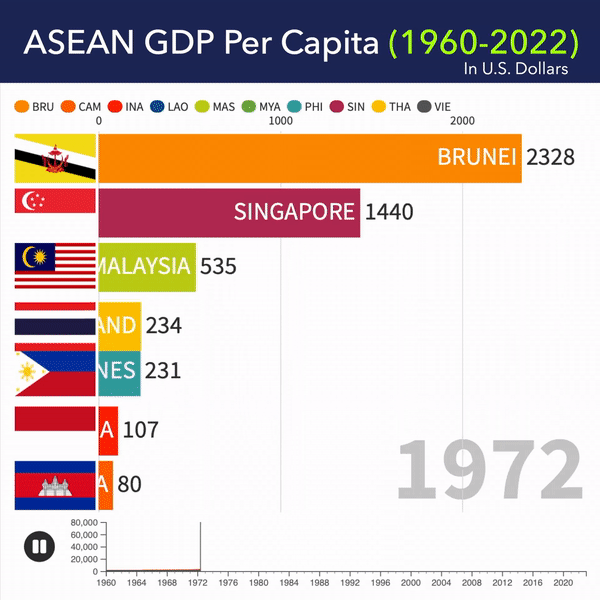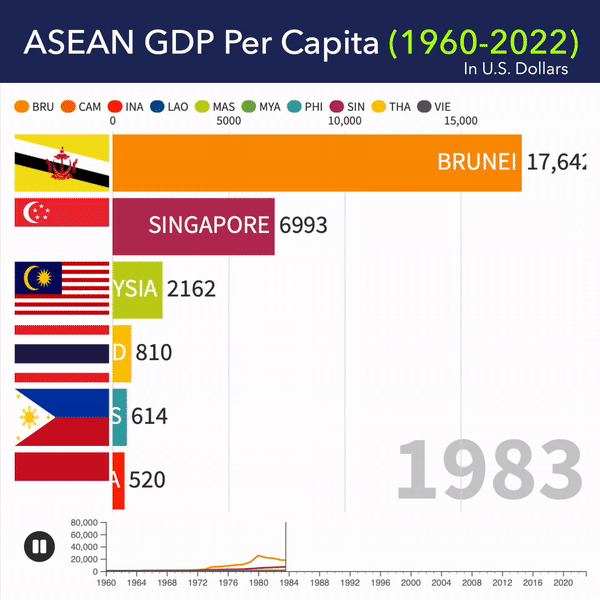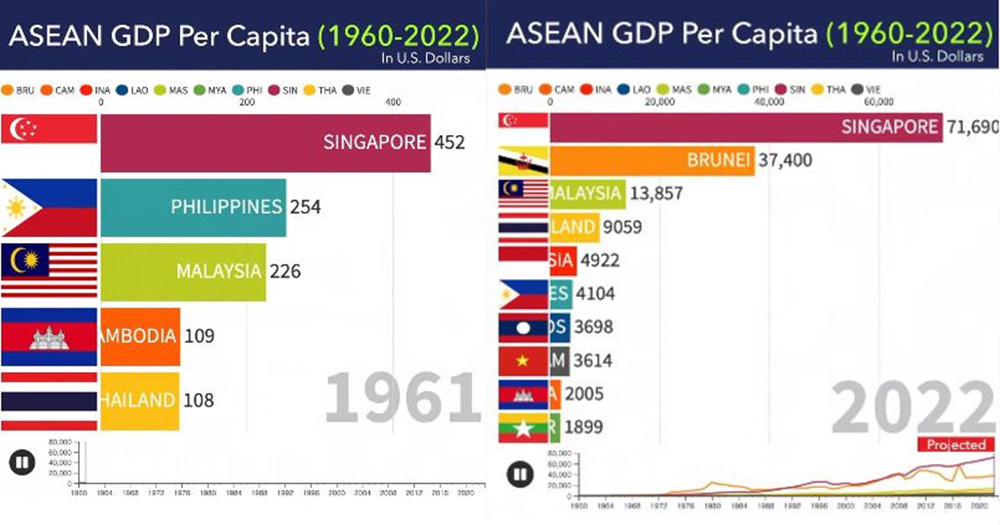Since 1960, both Singapore and Brunei have been the Southeast Asia's richest states, judging by gross domestic product per capita.
This little nugget of information comes from a video put up online, which showed how countries in the region fare over six decades when they go neck-to-neck in a multiple-horse race.
1st and 2nd place for over the past 50 years
Starting from 1960 and projecting into 2022, the video uploaded on Jan. 11 has captured many people's attention, as it has been viewed some 194,000 times in a week since Jan. 11.
Emerging tops in the first and second place throughout the video were Singapore and Brunei, with the two countries taking turns to displace each other.Singapore always had a high GDP per capita
The video started with only five countries, with Singapore in first place as the richest in the region.
Four of the countries featured - Malaysia, Thailand, Singapore, and the Philippines - are founding members of the Association of Southeast Asia (ASEAN).
This could be due to the lack of accurate economic data compiled by the other countries, resulting in them not being featured at this early stage as meaningful comparisons cannot be made.
Singapore fell to second place in 1965 when Brunei appeared in the race and immediately usurped the first place with a GDP per capita that was more than twice that of Singapore's.
 Source: Gif of video from Proprogress Philippines Facebook
Source: Gif of video from Proprogress Philippines Facebook
This change was likely due to Brunei's discovery of the South West Ampa gas field in 1963, which allowed Brunei to embark on the construction of a liquefied natural gas (LNG) plant.
Brunei then continued to hold the lead as ASEAN's richest country by GDP per capita for the next 25 years until 1990, with a particularly large surge in 1973.
 Source: Gif of video from Proprogress Philippines Facebook
Source: Gif of video from Proprogress Philippines Facebook
This surge was likely the result of two factors: Brunei's completion of its LNG plant in 1972, and the quadrupling of oil prices in 1973, as a result of an embargo imposed by the Arab-dominated Organization of Petroleum Exporting Countries (OPEC) against the U.S. for supporting Israel in the Yom Kippur War.
And in 1985, in a blink-and-you'll-miss-it-moment, Singapore's GDP per capita actually dropped, marking the country's first post-independence recession.
 Source: Gif of video from Proprogress Philippines Facebook
Source: Gif of video from Proprogress Philippines Facebook
Singapore overtook Brunei in 1990 and remained there
Subsequently, Singapore overtook Brunei in 1990 to remain at the top of the graph for the rest of the video, with the exception of a brief moment in 2007, in which Brunei displaced Singapore once more.
 Source: Gif of video from Proprogress Philippines Facebook
Source: Gif of video from Proprogress Philippines Facebook
 Source: Gif of video from Proprogress Philippines Facebook
Source: Gif of video from Proprogress Philippines Facebook
An explanation for this growth can be found in a August 2015 speech by the managing director the Monetary Authority of Singapore, Ravi Menon, which highlighted that the 1985 recession revealed structural strains in the economy.
This brought about a fundamental review of economic strategies, which resulted in the "rise of modern services as a twin engine of growth alongside manufacturing" up to the global financial crisis of 2008.
And if you also noticed that Singapore's GDP per capita dropped in 2008, this was due to Singapore also slipping into a recession as a result of the crisis.
Why have Singapore and Brunei been the region's richest countries?
As ASEAN countries, Singapore and Brunei are quite different in nature. The former is seen as a country that is resource-poor, while the latter is a resource-rich country.
But there is one thing both countries have in common - they are the two smallest countries in ASEAN with the two smallest populations.
The merits of high GDP per capita must be considered alongside how it is calculated, which is by dividing a country's gross domestic product by its total population.
A small population has a higher chance of economic success -- a fact that Singapore Ambassador-at-large Tommy Koh highlighted in The Straits Times in 2016, in which 14 of the world's 20 richest countries have a population of less than 10 million.
Koh has acknowledged, however, that GDP per capita is not necessarily the best criterion of human welfare in a state, given that there are other factors to consider, such as a country's achievements in housing, health, education, gender equality and fighting corruption.
And in any case, if there's one thing that the video has confirmed, it's that Singapore was not quite a fishing village in the 1960s.
You can also watch the video here:
If you like what you read, follow us on Facebook, Instagram, Twitter and Telegram to get the latest updates.
